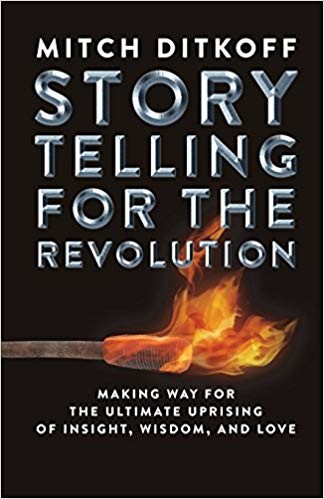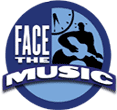Reimagining Discipline

Soon after launching my new online course on the creative process, I began talking with the people who enrolled. I was curious to discover what kind of obstacles they were facing -- the "stuff" that got in the way of manifesting their own creativity.
No matter how different the people I spoke to, how unique their background, experience, accomplishments,gender, world view, or astrological signs,they all said the same thing -- what I later came to refer to as the "D" word.
"DISCIPLINE."
That's what they all believed was missing from their lives. The lack of discipline was their Achilles heel, they confessed to me -- their problem, their weak spot, their #1 concern.
For the first few weeks of listening to their lament, I agreed. After all, discipline was important, right? I mean, who could write a book or start a business, or launch a product without discipline? Plus, I was disciplined, and if I, the creator of the course, was disciplined, then discipline must be important, eh?
Well, sort of. In the end, it all depends on WHERE this so-called "discipline" is coming from.
The more I listened to aspiring creators talk about their lack of discipline, the more I began to see how deficient they felt... how inadequate... how not-up-to-the task of creating something new and wonderful.
There was a massive heaviness at the root of their lament... a weight... a density that did not feel empowering -- how high school kids often feel, on a Sunday, afternoon, when they realize they haven't yet done their geometry homework.

Curious, I looked up the definition of discipline -- "the practice of training people to obey rules or a code of behavior, using punishment to correct disobedience." Oy. Then I looked up its etymology.
One source explained that the word "discipline" comes from "discipulus", the Latin word for pupil -- the same root as the word disciple.
Another source noted that the word "discipline" originates from the Latin word "disciplina", meaning "instruction and training" -- derived from the root word "discere" which means "to learn".
Very interesting, indeed.
People who become disciples are people who are deeply moved to learn something. Their actions and behaviors that follow are merely practical expressions in service to what it is they want to learn.
Their motivation is intrinsic. Their performance of specific actions emerges from their recognition that these actions will yield the results they are looking for.
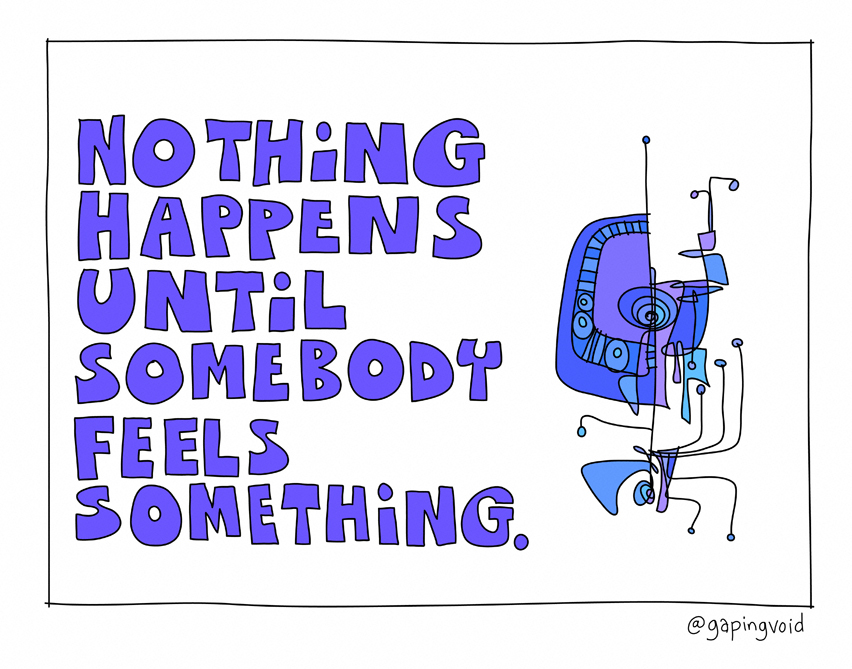
In other words, their discipline is rooted in love, devotion, and choice -- driven by a deeply held inner aspiration.
"Should" is not the disciple's operational word. "Need" is. And "want." And "responding to an inner calling."
Researchers who have studied creativity have come to the same conclusion.
"Intrinsic motivation" is the driver, not carrots and sticks.
When a person is moved from the inside to create something new, their motivation is natural, not forced. They are not doing geometry homework.They are following their fascination and inner calling. And though, to outside observers, they may seem disciplined, they are merely being moved by an unstoppable force within themselves.
How much discipline does it take to eat when you're hungry? How much discipline does it take to look up when you see a rainbow? How much discipline does it take to hug someone you love?
And so, if you are telling yourself that you "need more discipline," I invite you to take a fresh look at your situation.
Do what you can to connect with your original vision to create something new and wonderful. Feel what that felt like. Tune into your childlike curiosity. Rediscover your intrinsic motivation and stay with it. Let that move you. The discipline you keep telling yourself you need will naturally emerge.
Let love, fascination wonder, intuition, and trust run the show.
How to spark brilliance, breakthroughs and bold possibilities
MitchDitkoff.com
Posted by Mitch Ditkoff at 09:54 AM | Comments (0)
July 02, 2023Sun Tzu on Preparation

"Every battle is won or lost before it is fought." - Sun Tzu
What challenge or opportunity is coming up for you that will require a higher level of preparation than you usually make? What extra effort are you willing to make in order to prepare? What might prevent you from making the kind of effort you know you need to make?
How can you create the support you need to ensure that your preparation efforts succeed?
MitchDitkoff.com
Posted by Mitch Ditkoff at 10:04 AM | Comments (0)
April 07, 2023The Awesome Power of Immersion

"If I had an hour to solve a problem," explained Albert Einstein, "I'd spend the first 55 minutes thinking about the problem, and the last five solving it."
Translation? One of the secrets to having a big breakthrough is immersion -- "the state of being deeply engaged, involved, or absorbed."
Immersion is the ocean in which our fabulous insights, ideas, and illuminations are swimming. That's why Yogis seek out caves, embryos gestate, and writers go on retreat.
And that's why my business partner, Steven McHugh, and I rented a townhouse in Boulder, Colorado for 30 days and 30 nights when it was time for us to start up Idea Champions. We knew we had a great idea for a business, but we also knew that ideas were a dime a dozen and that unless we really immersed we'd end up with nothing much more than a charming story to tell at cocktail parties -- the idea for a business, but not the business itself.
Armed with little more than a flip chart, a few marking pens, and a burning desire to create something new, we unplugged from all our other commitments and jumped in with both feet.

We talked. We walked. We walked our talk. We noodled. We conjured. We brainstormed, blue-skied, dialogued, role played, invented, read, sang, stretched, drank coffee, wine, the crisp Colorado air, and whatever else it took to free ourselves from the gravity of what we already knew. If this was Rocky 1, our townhouse was the Gym, Adrienne nowhere in sight.
And every night before we went to bed, blissed out of our trees, we'd remind each other to remember our dreams and speak them aloud the first thing in the morning.
CLUES. We were looking for clues, hints, perfumed handkerchiefs dropped by our muse while we slept and anything else that bubbled to the surface of the imaginal stew we found ourselves now swimming in.
Crackpots? No. More like crockpots, simmering in our own creative juices, unimpaired by the almost infinite amount of distractions we had grown accustomed to calling our life.
Immersed. We were completely immersed -- two eggs submerged in the boiling water of creation, heat turned up, lid on, timer off.
Our walls? The walls of our abode? Covered with paper, sketches, scribbles, post-its, quotes, pictures, lists, charts, diagrams, questions, and take out menus -- the barely decipherable hieroglyphics of our journey into who knows where.
The floors? Our mothers would have had a heart attack, littered as they were with anything we didn't have a place for. Rube Goldberg meets Fellini. Yin meets Yang meets Jung -- the flora and fauna of two aspiring entrepreneurs on fire with possibility.

But our immersion went far beyond the four walls of our abode. It was a state of mind, not a geographical location. It didn't really matter where we were. Walking by the creek or sitting in a bar was all the same to us, ruled as we were by our shared fascination, random silken threads of conversation with complete strangers, and the increasingly apparent sense that we were on to something big.
And then, on the morning of the 19th day, very much at ease in our townhouse abode, there was a knock on the door -- a loud and insistent knock, a knock both of us found rather odd since nobody knew where we lived -- or so we thought.
"It's open," Steven shouted from across the room. "Go ahead and let yourself in."
And there, at the threshold, stood a woman neither of us knew, a woman boldly announcing that, for the past three days, she'd been hearing about "these two creativity guys" and she just had to meet us, her business now on the cusp of either breaking through or breaking down.
I don't remember a single thing of we said, but whatever it was hit the nail on the head.
The next day, there was another knock on the door. Apparently, someone else had heard about our whereabouts. This guy had a business, too, or was trying to have a business. He spoke. We listened. He spoke some more. We listened some more, occasionally asking a question or two and sharing some insight. He too, got what he needed.
On the third day, Jesus did not rise from the grave, but, yes, there was another knock on the door -- just enough proof to the logical part of our minds that the previous two visits were not random events, but part of some kind of emerging pattern -- what fans of Rupert Sheldrake might refer to as manifestations of the morphogenetic field, or what less metaphysical folks might describe as our very own "field of dreams."
Steven and I had done nothing at all to draw these people to us -- no ads in the paper, no posters on poles, no calls, no emails, no flyers, no social marketing campaigns. The only thing we'd done was immerse -- dig deeply into our own highly charged process of creating something new.
But this "nothing at all" wasn't nothing at all. It was something -- something grand and glorious. Something extraordinarily attractive.

Is a mother hen sitting on her egg doing nothing at all? Is she slacking? Is her seeming disappearance from the poultry marketplace a sign of irresponsibility?
To the casual observer, maybe that's what it looks like, but nothing could be further from the truth. Sitting is exactly what the mother hen needs to do in order to bring new life into the world. Stillness, not action, is her path.
Did Steven and I accomplish what we set out to do during our 30 days of immersion? Yes, we did. In spades. Beyond the inspiration, collaboration, and good feelings we experienced, we emerged with the design of our first product -- a creative thinking training we ended up licensing to AT&T just two years later for a truck load of money.
Was our immersion time all fun and games? No way. Chaos and confusion were our housemates, but the rent they paid sparked a ton of learning, creativity, discovery, and a new found willingness to make friends with the unknown -- what Henry Miller was referring to when he defined confusion as "simply a word we've invented for an order that is not yet understood."
In today's business world, immersion is a very rare commodity. ADD rules the day. Time is sliced and diced. We don't have time. Time has us. We tweet, we delete, we tap our feet, but all too often nothing much beyond the status quo ever really happens. Downtime has become an anathema -- the province of "B list" players. Busy-ness and business have become synonymous.
The assumption? The more we do and the faster we do it, the more success we'll have. Boil an egg? Ha! We microwave it -- even if it tastes like shit. Dive in? No way. We hydroplane.
But it doesn't have to be that way. It really doesn't.
Slowing down and going deep trumps speeding up and going crazy. Immersion trumps diversion. It's possible. Yes, it is. I have proof. And so do YOU, if only you would pause long enough to remember those extraordinary times when you unplugged, tuned in, and dove into your own process of creating something new and wonderful.
A QUESTION FOR YOUR CONSIDERATION:
What can you do, this week, month, or quarter, to unplug from the daily grind and give yourself the luxury of immersion? Where will you go? When? And who will you invite to accompany you, if anyone?
Excerpted from my forthcoming book: WISDOM AT WORK: How Moments of Truth on the Job Reveal the Real Business of Life.
Excerpted from Storytelling at Work
MitchDitkoff.com
IdeaChampions
Posted by Mitch Ditkoff at 08:58 PM | Comments (0)
February 14, 2023Three Ways to Breathe Life Into Your Most Passionate Creative Venture

If you are on the cusp of a new venture that fills you with both excitement and doubt, welcome to the human race.
Most aspiring innovators on the brink of a breakthrough assume they need to be in a doubt-free state if they are going to succeed and that anything less is a sure sign that they are either imposters, fools or losers-in-waiting.
Not true.
The experience of doubt (and it's twin cousins, fear and dread) comes with the territory of starting a new venture. What's needed, wrote Rollo May in his extraordinary book on the topic, is courage -- the courage to create.
How will you develop the courage YOU need? In many ways.
One way to begin is to be encouraged and that, precisely, is what the following three links will help you experience.
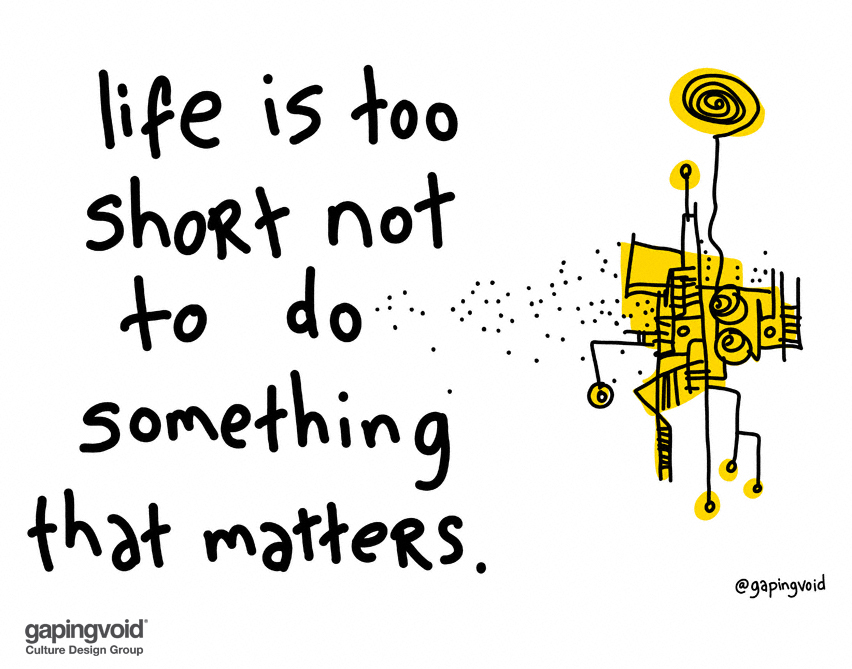
Clarify Your Vision
Frame Your Real Question
Make More Time to Create
NOTE: After you complete any or all of the above self-inquiry pages, you have three choices: 1) You can click "submit", which will enable the creator of these pages to read your response (and maybe reply); 2) You can save what you wrote as a PDF for later reflection. 3) You can do both.
Illustration #1: Samuel Zeller, Unsplash
Illustration #2: gapingvoid
Posted by Mitch Ditkoff at 04:45 PM | Comments (0)
January 16, 2023Entering the Theater of Your Own, Unique Creative Process

The creative process is a most mysterious one -- the inner journey a person takes to transform an impulse, idea, or inspiration into a manifested form that other people can enjoy.
For most of us, the creative process begins with the undeniable recognition that we are being called to express something -- to give shape to the invisible. Usually, the beginning of this process is quite intoxicating. The sky's the limit. Anything is possible. All systems are GO. Whoo hoo!
In time, however, things change. Our muse, once pristine, now has warts and we enter into the phase sometimes referred to as the "messy middles." Where once everything seemed clear, now nothing is. Confusion, distraction, and procrastination rule the day. The light at the end of the tunnel? Now more fluorescent than divine.
This messy middles phenomenon, is not only common, it's predictable, and its been going on for thousands of years. All journeys have obstacles. Every fairy tale has it's Big Bad Wolf. Obstacles are not the problem. The problem is how we relate to the obstacles.

Here's another way to look at this phenomenon: Imagine yourself walking into a theater from the bright light of day. It's a show that's been highly recommended to you and you've driven a long way to get there. You can't wait to take your seat and enjoy it. But you can't take your seat because you can't see anything.
Your eyes, upon entering the theater, have not yet adjusted to the dim light. From where you're standing, you have no idea if there are any seats at all and, even if there are, you can't see them -- your pupils having just majorly dilated. You can't even see the aisle. But if you are patient a little while longer and... just... stand... there... your pupils will expand and you'll be able to SEE what has always been there.
Where just a few seconds ago nothing was apparent, now everything is. Indeed, sometimes the grand vision we seek is just a matter of our eyes adjusting to the available light.
FOR YOUR REFLECTION: Yes, you have entered the theater of your own creative process. Congratulations! And yes, you have found your way to the theater of creation. Fantastic! But your two eyes, at this moment in time, may not have completely adjusted to the available light. And so, you will need to stand there a little... while... longer... while your vision adapts. You might feel impatient. You might feel helpless. You might even feel like you're missing something -- but there's no way around it.
Of course, there are some theaters with ushers who will be happy to guide you to your seat. Though less and less common, these days, it is always a possibility. If this describes the theater in which YOU now find yourself, hallelujah! WHO might that usher be for you and how can you get their attention? And if there is no usher, what can you do to stand your ground just a little while longer, at the back of theater, while your eyes adjust to the light?
This course will help your eyes adjust to the light
Who is this course for?
74 more articles of mine on Medium
Photo #1: Jake Hills, Unsplash
Photo #2: Felix Mooneeram, Unsplash
Posted by Mitch Ditkoff at 11:08 AM | Comments (0)
October 30, 2022The Challenge Creative People Face

Here is one of the biggest challenges creative people face: finding the right balance between spontaneity and planning.
Spontaneity, while a huge part of the creative process, can also be a huge curse. The intoxicating nature of spontaneity -- and the likelihood that it will lead to more projects -- has a tendency to sidetrack. It's sparkly. It's fascinating. And it's fun. But it can also be a massive distraction.
The result? Many creative people have more projects "on the table" than they can execute. And while this often makes for good cocktail party conversation, it also makes for overwhelm, stress, and eventual self-loathing. Months go by (sometimes years) and the big, hairy, audacious goal remains just that -- a goal -- not a completion. The antidote? A renewed vision of what success looks like. Focus. Priorities. A game plan. A support team. And the day-by-day effort required to work the plan.
Bring your current, most fascinating project to mind. Now imagine that your efforts are totally successful. What does success look like? And how did you get there?
50 Awesome Quotes on Vision
Idea Champions
Posted by Mitch Ditkoff at 07:15 AM | Comments (0)
August 15, 2022What Drives Creativity?
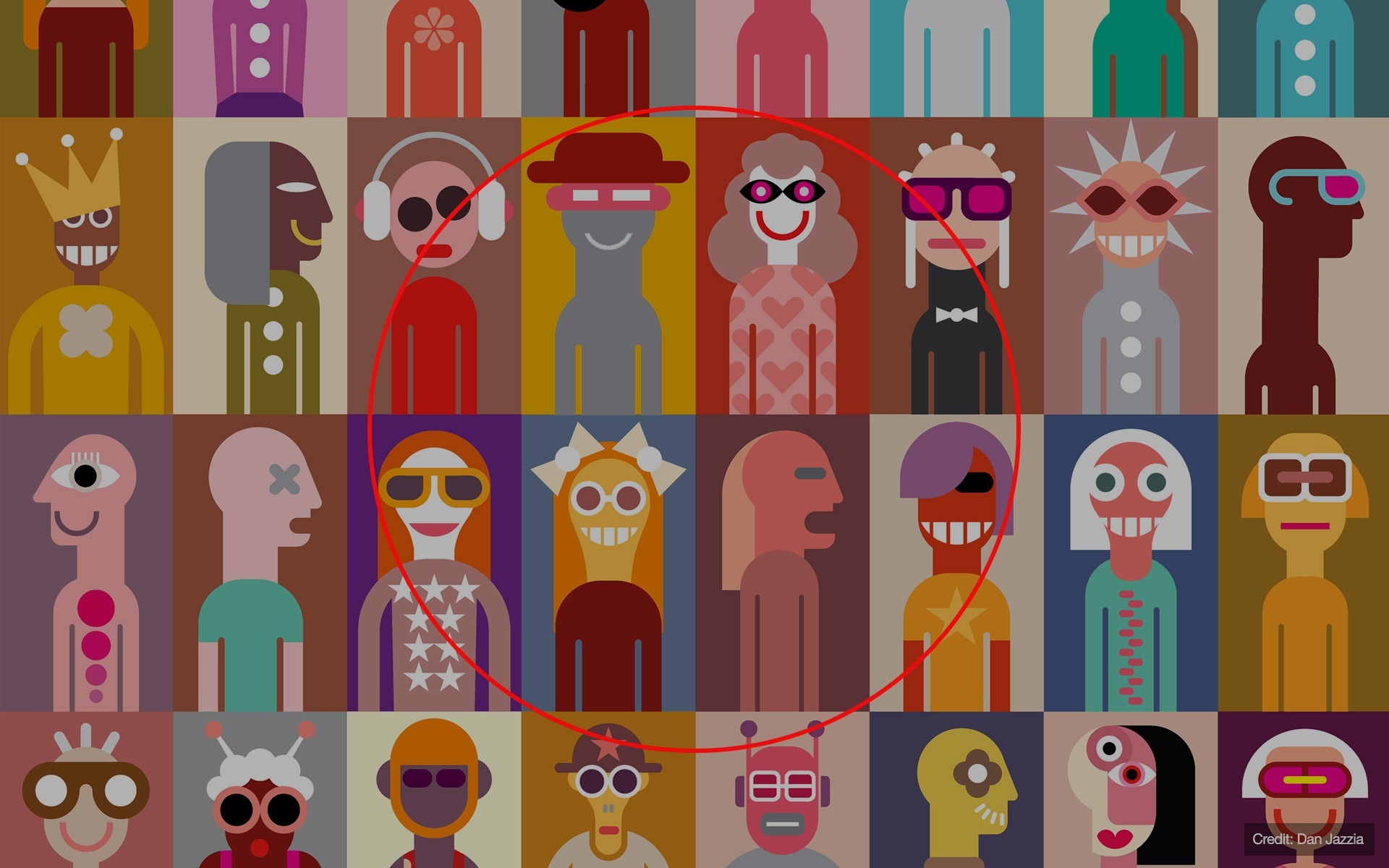
If you have 23 minutes to spare and want to get some insights into what drives creativity (and what gets in the way), I invite you to click this link and listen to Gil Hanson's interview of me on his BE YOUR BEST podcast
Gil is a master facilitator of the process that enables people to understand, embrace, and design their own personal brand, no matter what their profession.
The podcast will be especially interesting to you if you are thinking of enrolling in my two-month, online Year of Living Creatively course which begins on September 12th.
Posted by Mitch Ditkoff at 02:29 AM | Comments (0)
April 13, 2021An Invitation to Dive Deeper Into Your Own Creative Process

"The creative process is a process of surrender, not control." -- Julia Cameron
The creative process -- the experience a human being enters into in service to their passion to manifest something from nothing -- is a mysterious one, even though it has been studied for decades by psychologists, neuroscientists, and researchers.
Consider this: everything you are seeing right now began as an idea in someone's mind -- the laptop, the cell phone, the chair you are sitting on, paper, paint, your desk lamp, picture frame, credit cards, books, halvah, and a whole lot more.
At one point, none of these things existed. And then they did. Somebody, somehow, someway conjured them up and successfully navigated their way through the twists and turns of the creative process until what they saw in their mind's eye became a reality.
The yoyo. The Sistine Chapel. The internet. Cheese. Dental floss. Cartoons. Beethoven's Fifth. Poetry. Gardens. Socks. Noodles. Earplugs. The Mona Lisa.
What do you think the originators of these manifestations went through? What journey did they travel to transform their inspired visions into reality?

For the moment, let's call their experience "the creative process."
Perhaps the most dramatic example of this phenomenon can be distilled down to four words: "Let there be light" -- supposedly the words of the prime Mover and Shaker, better known as.... drum roll please... THE CREATOR -- the one who, at the very beginning, created everything out of the nothing. Nebulae. Swirling gases. Galaxies. Black holes. White light. Space. Atoms. Molecules. Peacocks. Cockroaches. And, eventually, human beings.
All of this came into being via the primal expression of intention and declaration. Somehow, someway, somewhere there was a power that had the knack for CREATING simply by declaring it.
Of course, none of us were there at that alpha and omega moment to verify any of this. Not CNN. Not Fox News. Not Edward Snowden. And even though all we have are creation myths to go by, there is something about this "in the beginning" stuff that resonates with us -- an inkling that it is possible for something to be created out of nothing.
Can I get an AMEN?
Our version of this something out of nothing business is a tad less dramatic than what went down at the beginning. Our version is more like Let There Be Lite Beer.
And yet, we too, imperfect as we might be, also have the ability to create something out of nothing -- or COULD, if we only we....
Ah... if only we could WHAT?
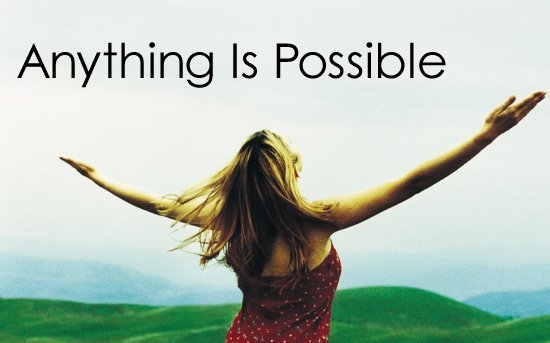
What is it that enables a human being to go from an idea in their imagination -- the concept of something -- to its realization? And, on the flip side, what gets in the way?
Is there a formula, map, or algorithm to follow? No, there isn't. But there IS a path -- the path that's made by walking on it. And the more we walk this path, the more it opens up, and the more it opens up, the more we discover what we need to experience in order to continue on that path -- much of which has been described in many beautiful ways, for centuries, by those who have gone before us and lived to tell the tale.
DaVinci. Michelangelo. Helen Keller. Einstein. John Lennon. Georgia O'Keefe. Nicola Tesla. Frank Zappa. Joseph Campbell. And a whole lot of other people -- lesser known -- with stars in their eyes and dirt under their fingernails.
Fascinated with the creative process, I have studied many of these people and whatever "maps" they may have left behind -- all of them indicating, in their own way, there IS a treasure buried somewhere.
Of these maps, the one that makes the most sense to me is the one drawn by Joseph Campbell, maestro of the "Hero's Journey" -- a blueprint of the human journey he discovered after deconstructing the stories of just about every culture on planet Earth, realizing, along the way, that ALL of the stories followed the same basic arc -- that, indeed, there is a universal, archetypal plot that weaves its way through our lives -- and that being mindful of this arc has extraordinary value, a kind of GPS for the soul's journey.
The value of this GPS? It positions us in time and space. It provides reference points. And it radically increases the odds of us being in the driver's seat, instead of the trunk.
For now, let's take a brief look at the five stages of the Hero's Journey (a distillation of Campbell's 17-step process elegantly crafted by Dr. Beverly Nelson and Joseph Dispenza) and how it relates to YOU, someone about to embark on their own creative journey -- one with at least a few Minotaurs, sirens, and Big Bad Wolves lurking in the shadows.

1. THE CALL TO JOURNEY: Have you ever felt called -- like the universe itself, was tapping you on the shoulder to get your attention -- that there was something for you to DO that absolutely HAD to be done and that if you DIDN'T do it you would end up feeling like you had chickened out? This calling is always preceded, according to Campbell, by some kind of disruption -- the end of the status quo and the recognition, as Dorothy in the Wizard of OZ so memorably stated that, "Toto, we're not in Kansas any more."
This disruption can take many forms. It can show up as a traumatic event, like a near death experience, the end of a marriage, the loss of a job, your home burning down, or Covid-19. Or, it might show up in a more intoxicating way -- like a dream, epiphany, or visitation from your muse.
Most commonly, human beings resist The Call to Journey. Where letting go would, ultimately, be the right move, we hold on. We tighten, clench, dig in our heels, cling to the past, and procrastinate.
If YOU are thinking of enrolling in The Year of Living Creatively (or have already enrolled) it is likely that you are feeling called -- that something deep within you has gotten your attention and you are now at the intersection of "Life As I Know It" and "I Have No Fucking Clue." Welcome to the fun house. Let the games begin!
2. THE PREPARATION: In order to transform nothing into something, you will need to prepare for the transformation. You will. There is no way around it. Farmers do this every season. Committed to having a harvest, they roll up their sleeves, plough their fields, fertilize the soil, and do whatever is needed to help nature take her course. You, too, will need to roll up your sleeves. You, too, will need to prepare for your creative journey. What, specifically, this preparation looks like is completely up to you. By the way, The Year of Living Creatively can help.
3. THE ENCOUNTER: Every aspiring creator eventually runs into obstacles. Every fairy tale has its Big Bad Wolf. Luke Skywalker had Darth Vader. Cinderella had evil stepsisters. And Jesus had Judas. That's just the way it is. Or as the Buddhists like to say, "No mud, no lotus."
The obstacle is not the problem. The problem is how you relate to the obstacle. Do you freeze, procrastinate, stick your head in the sand, and eat another quart of ice cream -- or do you summon your courage and proceed?
The good news? In the Hero's Journey, allies and mentors show up all along the way to offer their help, bearing all kinds of gifts -- winged sandals, mirrored shields, magic beans, and maybe a foot massage. For the moment, think of The Year of Living Creatively as an ally of yours -- the assistance you need to help you navigate the creative process with as much power, resilience, and confidence as possible.
4. THE HOMECOMING: All major rites of passage have some kind of "honeymoon period" associated with them -- the intoxication phase when everything is new and our lives are animated by the energy of "anything is possible." That's a good thing. It keeps us in the game. It provides the fuel we need to keep on trucking. Eventually, however, this phase comes to an end. The buzz wears off. Holy Grail having been discovered, head of the Minotaur having been decapitated, we need to integrate what we've learned. We need to sustain the effort on a daily basis -- the "chopping wood and carrying water" phase of life when we practice what we've preached (or what's been preached to us).
In Joseph Campbell's taxonomy of life, this is known as the Homecoming -- the part of the process when the hero, after all kinds of adventures, gets the chance to LIVE their wisdom. The mountain has been climbed. Now it's time to do the laundry with the same consciousness that received the Ten Commandments the week before.
5. THE TELLING OF THE TALE: Storytelling is our species' most powerful way of sharing what it knows -- a form of communication that has been going on forever. Indeed, neuroscientists tell us that human beings are hard-wired for storytelling. It's what we do and how we do it -- translating our life experiences into a form that not only attracts attention, but delivers our message in the most memorable way possible -- the message of what we've learned... and what we know... and what will be useful for other people to consider as they continue on their journey -- or, perhaps, return from one.
The Telling of the Tale is the final stage of the Hero's Journey and, for those of us attempting to unleash our creativity -- a way to clarify our wisdom and be of service to others at the same time. YOU, as someone on the journey will not only be on the receiving end of many tales, you will also be the teller of tales -- the deep expression of what you've learned along the way. Your insights. Your moments of truth. And, ultimately, your wisdom.
And all in service to the greater good.
"The privilege of a lifetime is being who you are." - Joseph Campbell
More about The Year of Living Creatively
Some of the topics we cover
The back story
The creator of The Year of Living Creatively
Posted by Mitch Ditkoff at 12:53 PM | Comments (0)
January 01, 2021THE YEAR of LIVING CREATIVELY: Unleash Your Creative Mojo

While it may be true that most "ideas are a dime a dozen," some ideas are actually priceless -- and that includes at least one of yours. You know... that idea for the new venture you want to launch... or the book you want to write... or the change you want to make -- that deeply felt possibility bubbling up from the core of your being.

And yet, at the same time, there also seems to be some forces, both internal and external, working against you that have had their way with you -- those metaphorical Big Bad Wolves on your way to Grandma's House.
But guess what? It doesn't have to be that way. It doesn't. You have the power, discernment, courage, and mojo to gracefully work your magic in the world. And that is, precisely, what The Year of Living Creatively is all about -- an engaging, provocative, online GPS to help you navigate your way through the often challenging creative process.
HOW IT WORKS: Once a week, you will receive an email with a link to a "fill-in-the-blanks" self-inquiry exercise designed to increase your odds of succeeding -- a simple, "chiropractic adjustment" of your own, innate creativity. Twenty minutes, per week, is all it will take. Or less. That and the willingness to pause, reflect, and respond.
Subscribers will also be invited to participate in a series of 12 monthly Zoom sessions, facilitated by the founder of The Year of Living Creatively -- an inspiring way to be part of an ever-growing community of creative thinkers and doers. Additionally, you will have the option of pairing up with one or two other subscribers for ongoing support, brainpower, encouragement, and accountability.
THE BENEFITS:
- Increase your odds of success
- Maintain positive momentum
- Clarify your vision
- Go deeper into your creative process
- Originate breakthrough ideas
- Stay energized and inspired
- Go beyond your limiting assumptions
- Take more risks
- Increase the odds of attracting alchemical collaborators
Subscriptions to The Year of Living Creatively will be available in 2-3 months (fee still-to-be-determined). If you want to be alerted when this service launches, send an email to office@ideachampions.com with the words "The Year of Living Creatively" in the subject line.
"If not YOU, who? If not NOW, when?"
The creator of the service
Idea Champions
Posted by Mitch Ditkoff at 10:57 AM | Comments (2)
December 11, 2019On Creating an Innovation Mindset

If you want to spark innovation in your organization and are looking for the diamond cutters stroke, consider storytelling. Since 1987, I've tried everything under the sun to help my clients raise the bar for innovation. What I've discovered is that innovation begins in the mind and that unless people are in the right mindset, innovation will never be more than a pipe dream. Storytelling, I've learned, is the simplest, fastest, most memorable way to get people into an innovation mindset. Here's how we do it. And if you only have 90 minutes, this is how we do it. Its also boosts employee engagement.
I wrote the book
The back story
In our clients words
Posted by Mitch Ditkoff at 11:10 AM | Comments (2)
October 06, 2019A Real Life Example of the Power of Giving Feedback

Most Fortune 500 companies have some kind of corporate strategy in place for ratcheting up their innovation efforts. Consultants are hired. CEOs give pep talks. And internal initiatives are launched.
To the casual observer, it all looks good, but few of these initiatives ever amount to anything In fact, research indicates that 70 percent of all change initiatives fail.
Why such a low percentage? It depends on who you ask. Senior leaders see it as a workforce issue. The workforce sees it as a senior leader issue. Consultants see it as an issue their company is best suited to resolve. And the occasional in-house astrologer sees it as a Gemini in Pluto issue. Bottom line, nobody really knows.

Here's how I see it: one of the biggest (and least addressed) reasons why most change initiatives fail can be traced back to the cro-magnon way most innovation-seeking people give and receive feedback -- especially when it comes to pitching high concept ideas.
Case in point: Some years ago, Lucent Technologies asked me to facilitate a daylong "Products of the Future" ideation session for 75 of their best and brightest. The pay was good. The challenge was compelling. And I was going to have carte blanche to design the session just the way I wanted.
Or so I thought.
The woman who had contacted me, I quickly found out, reported directly to the CEO. So far, so good. And her concept of the session was spot on -- that the CEO and his Direct Reports (a new rock band?), would make an appearance at the end of the day to listen to five BIG IDEA pitches and then give their feedback, real-time.
Theoretically, this made perfect sense. But theory and reality are two very different things -- kind of like the difference between asking your teenage daughter to clean up her room and her actually doing it.
The harsh reality is this: The vast majority of Senior Leaders are not very skillful when it comes to giving feedback -- especially in response to ideas that challenge the status quo. "Feedback," for them, has become code for "With all due respect, let me tell you why your idea sucks".
As a facilitator of high profile brainstorming sessions, I cannot, in good faith, allow this all-too-predictable dynamic to play itself out. Not only will potentially profound ideas be prematurely dismissed, the hard-working, brilliant people who have spent all day generating and developing these ideas will become royally pissed, disempowered, humiliated, passive/aggressive, and depressed. The result? Very few of them will want to participate in future sessions.
So I told the consultant-seeking woman from Lucent that I, in service to the outcomes she was about to hire me to ensure, needed to meet with her CEO so I could teach him and his team how to give effective, humane feedback to a roomful of 75 future product generating optic fiber geniuses.
 "Impossible!" was her response. "Our CEO is very busy man -- and besides... he doesn't like consultants."
"Impossible!" was her response. "Our CEO is very busy man -- and besides... he doesn't like consultants."
"Got it," I said, quickly assessing my options. "And thank you, so much, for your kind invitation to facilitate the session, but I must respectfully decline" -- and, with that, I began packing up my briefcase.
This, shall we say, caught her slightly off guard. "I... don't understand where you are going with this," she replied.
"Look," I said. "If you want to get meaninful results from an all-day brainstorming session, especially if you are flying people in from who knows where, we've got to be absolutely sure that the feedback at the end of the day is done well. I am not going to walk 75 of your best and brightest people off the plank."
I could tell that my unexpected feedback was registering. "OK, OK...but the best I can do is get you five minutes with him during the coffee break just before the report outs".
"Great," I said. "I'll take it."
Fast forward two months.
From 8:30 am -- 3:00 pm, 75 of Lucent's most brilliant technologists conjured up products that made my head spin. The room was abuzz with glorious possibilities. The sense of accomplishment was palpable. At 2:45 they selected five of their best ideas and summarized them on flipcharts. At 3:00, it was time for coffee and sugar, me craning my head for the CEO and his merry band of direct reports.
I envisioned him to be a tall man, silver-haired, with a large Rolex and a steely look in his eyes -- someone who might be good friends with the Governor and eventually have his portrait hanging in the lobby at headquarters. He was, much to my surprise about 5'6", wearing a Mickey Mouse t-shirt, loafers, and no socks. My kind of guy.
"Rich," I began, extending my hand. "Welcome, Mitch Ditkoff here from Idea Champions, facilitator of today's extraordinary ideation session, "how would you like to learn a simple technique in the next five minutes that will not only take all the dread out of giving feedback, but spark some seriously powerful idea development on the spot?"
He looked at me as if I'd just given him the holy grail. "You're on!"
"Great. Here's how it works," I began. "When an idea is pitched, first say what you LIKE about it -- the upside, what's promising. After a few genuine likes, then express your CONCERNS -- the stuff you probably wanted to say in the first place. But for each concern you express, it will be your responsibility to follow it with a SUGGESTION, a way that would resolve your concern and keep the idea alive Got it?"
"Got it."
"Oh... one more thing, Rich. If you forget to use the method, do I have your permission to remind you?"
"Absolutely".
The senior team took their place on stage, sitting behind a table, draped in black, that reminded me of the Nuremberg Trials. The 75 brilliant brainstormers took their seats at round tables -- everyone attentively listening to me describe the feedback process that was just about to unfold.

The first BIG IDEA pitch was excellent -- a compelling idea for a telecommunications platform of the future that was utterly mind blowing. The audience applauded, I acknowledged the presenter, and then gave the floor to the CEO, reminding him to use the feedback technique I'd taught him just a few minutes ago -- which he proceeded to do for, oh, maybe 30 seconds or so.
After that? It was Apocalyse Now meets The Godfather, with a little Don Rickles in Vegas thrown in for good measure, a scene I'd witnessed countless times before in corporate America -- the kneejerk, reptilian-brained, go-for-the-jugular tendency most senior executives have to focus on what's wrong with a new idea before what's right.
Speaking into the mic in my best baritone imitation of the Wizard of Oz, I quickly intervened.
"Oh Mr. CEO of a very large and profitable telecommunications company. Remember the LCS technique! First your LIKES, then your CONCERNS, then your SUGGESTIONS."
In an optic fiber nanosecond, he sheepishly smiled, thanked me for the reminder, and returned to the technique.
The rest of the session went off without a hitch. Five powerful ideas got pitched. Seven of Lucent's top executives weighed in with insight, honesty, and graciousness. And 75 aspiring innovators experienced something they had probably never experienced before -- that it was possible to spend all day brainstorming "out there" possibilities and get the kind of feedback from senior leadership that was honorable, empowering, easy-to-listen to, and immediately helpful.
SO WHAT? Ever hear the phrase "ideas are a dime a dozen." Of course you have. It's one of the classic truisms we were all brought up to believe. That old saw, however, is less about ideas being inconsequential, than it is about people not knowing how to elicit their value. Granted, not every idea is worth developing, but far too many good ones are lost along the way because the person to whom the idea is pitched is blinded by their own knee jerk reactions.
The literature is filled with examples of great ideas whose value was not immediately recognized. The steam engine. The MacIntosh. FedEx. And the Post-It Note just to name a few. All of them were pitched to the "powers-that-be" and all were victims of knee jerk, naysaying, idea killing behavior. Yes, it's true, many senior leaders beat the drums for "out of the box thinking". But when push comes to shove, as it often does, their drumming is more like fingernails on the edge of an office desk than a conga player with fire in his eyes. So let's give our senior leaders what they need to make the shift from theory to practice -- and that is a simple method for them to respond to new and untested ideas in a way that increases the odds of innovation actually happening.
NOW WHAT? Think about your style of responding to new ideas. Do you listen? Do you pause long enough to see the seed of innovation? Do you give meaningful feedback in a humane way? And what about your organization? Do people know how to give and receive feedback? Do they take the time? Does the process increase the odds of innovation becoming a reality? If not, what can you about it this week to turn things around?
Posted by Mitch Ditkoff at 06:46 PM | Comments (0)
December 12, 2018Allow More Time to Be Creative!
It doesn't get any simpler than this, folks! You want to be more creative? You want to create the conditions that allow other people you work with to be more creative? Stop rushing them! Go beyond the nanosecond! Allow more time!
Carl Jung chimes in
Idea Champions
Allow more time for storytelling!
Play time at AT&T
Posted by Mitch Ditkoff at 06:07 PM | Comments (0)
June 20, 2018How to Spark Innovation in Your Company in 10 Minutes Per Week

Do you work in an organization that is trying to raise the bar for innovation, teamwork, storytelling, and leadership, but doesn't have the budget to pay for trainings, keynotes, and workshops? Here's an alternative -- Idea Champions' Micro-Learning for Innovators service. It all happens online. At your own pace.
The price? YOU decide on the value of our service and make us an offer. 95% of the time we go with what our prospective clients suggest. 5% of the time we decline. Interested? mitch@ideachampions.com
Posted by Mitch Ditkoff at 10:23 AM | Comments (0)
April 26, 2018Micro-Learning for Innovators in Just 15 Minutes Per Week
 If you are looking for a simple, inexpensive way to spark innovation in your organization in just 15 minutes per week, here it is. No workshops. No trainings. No keynotes. No complicated idea management software. No headbanging. And the first three companies that respond to this post get to name their own price. Here's what one of our happy clients says about this innovative service of ours.
If you are looking for a simple, inexpensive way to spark innovation in your organization in just 15 minutes per week, here it is. No workshops. No trainings. No keynotes. No complicated idea management software. No headbanging. And the first three companies that respond to this post get to name their own price. Here's what one of our happy clients says about this innovative service of ours.
PS: If you want to know how much it costs, text me at 845.389.9096 and I'll let you know ASAP.
The creator of this service
The company he co-founded
This might be included
10 ways to enable innovation in the workplace
Another way of thinking about time
Posted by Mitch Ditkoff at 08:24 AM | Comments (0)
March 24, 2018Storytelling & the Creative Process
This is bleeping brilliant. Not only WHAT its says, but HOW it's presented. Two minutes on what it takes to really do creative work. Inspiring. Truthful. And in your face like a fresh arctic wind off a lake you've been waiting too long to sail on...
Ira Glass on Storytelling from David Shiyang Liu on Vimeo.
It took me four years to write this book
Idea Champions
Posted by Mitch Ditkoff at 03:06 PM | Comments (1)
February 06, 2018MICRO-LEARNING for Innovators (in just 15 minutes per week)

Innovation is a huge topic in organizations these days. Every company is looking for new and better ways to do more with less, differentiate themselves from the competition, and unlock the hidden genius of their workforce.
At the same time, many organizations are budget-constrained. Flying in an outside consultant to lead a workshop or training can sometimes be cost prohibitive. This I understand.
Which is precisely why my company, Idea Champions, is now offering Micro-Learning for Innovators, a cost-effective way to stir the innovation soup -- a virtual, self-organizing, just-in-time way to increase everyone's ability to be a proactive innovator on-the-job. And it only takes 15 minutes per week.
TOPICS INCLUDE: Mindset, Culture of Innovation, Creative Thinking, Idea Generation, Brainstorm Facilitation, Storytelling, Leadership, Teamwork/Collaboration, Listening/Feedback, Problem Solving

HOW IT WORKS:
1. You and I have a 20-minute phone conversation about WHY you want to raise the bar for innovation and creativity in your organization.
2. Based on your needs, I create a year-long, customized Micro-Learning for Innovators curriculum for you -- a landing page of links to 52 engaging articles and videos of mine on the topic (curated from more than 1,200 I have produced).
3. Each week (or month), for the next year, you forward selected links to your team (or whatever part of your workforce is participating in the program.)
4. Participants read/view the link(s) in preparation for their meeting (real-time or virtual) that you or one of your surrogates facilitates. All you need to reserve on your agenda is 10 minutes for the innovation topic. NOTE: This is micro-learning, not head-banging.
5. You (or your designated meeting moderator) facilitates the innovation-topic-of-the week conversation. This deepens learning, quickens the sharing of best practices, sparks creative thinking, ensures accountability, and establishes a robust, intrinsically motivated learning community.
OPTION #1: I send you a simple "Moderator's Guide" that helps ensure your weekly innovation-sparking conversations are as effective as possible.
OPTION #2: I participate on your launch call to help you set the context, inspire participation, and answer any questions your people might have about the value, purpose, and process of the program.
OPTION #3: At TBD intervals, throughout the year, you invite me to facilitate one of your online meetings/trainings.
FEE: Name your own price for an annual license. (In other words, you quantify the value of my service to your organization and make me an offer. If it's "in the zone," I will say YES. If your offer is below what I consider fair, we will talk and see if we can come to an agreement.
WHO CREATED THE PROGRAM? Mitch Ditkoff, Co-Founder of Idea Champions, Author of the two award-winning winning books on innovation and storytelling. Creator of a wide variety of storytelling workshops and keynotes. Innovation Blogger of the Year, two years running. Master storyteller. His clients.
Interested? email Mitch today: mitch@ideachampions.com
Our clients
What they say
Our workshops and trainings
One of our micro-learning partners
Posted by Mitch Ditkoff at 09:02 AM | Comments (0)
November 14, 2017A New Facebook Group for Aspiring Innovators and Cultural Creatives

After 28 years of being an "innovation provocateur" for hundreds of forward thinking organizations around the world, one thing has become very clear to me: most people with BIG IDEAS usually end up derailed somewhere along the way.
Simply put, they lose steam, lose heart, and lose their way. The result? No result.
This is why I have launched "Being a Creator on Planet Earth" -- a new Facebook group designed to help aspiring innovators, from every walk of life, manifest their big, bold, beautiful ideas. The content? Inspired quotes by creative icons, innovation-sparking articles, mind-opening videos, stories, best practices, and a sprinkling of tips, tools, and techniques. Juicy. Engaging. Fun.
Three minutes a day is all it takes. Sometimes, less than 60 seconds.
The Facebook Group
The creator of the Facebook Group
50 quotes on possibility
Posted by Mitch Ditkoff at 08:21 AM | Comments (0)
November 05, 2017Beyond Sage on the Stage Consulting

To borrow a phrase from the radically changing world of healthcare -- the essence of organizational culture change can be boiled down to three words: "Physician heal thyself"-- as in companies restoring optimum health to their enterprise from the inside out.
While many patients, anxious about their well-being, simply want the doctor to tell them what to do, that is, ultimately, a prescription for failure. Sustainable change only happens when people take full responsibility for their own condition.
Being told to "take two aspirins and see me in the morning" by someone with a framed medical school degree above their desk may be comforting in the short-term, but it completely misses the point. It's a paradigm whose time has come and gone.
The long and disappointing history of "change initiatives" bears this out. The data is there. 70% of them fail. And the main reason why 70% of them fail is because most organizations who enter into the culture change process rely too much on outside "experts" who, invariably treat their "patients" as someone incapable or unwilling to heal themselves.
Does the phrase "co-dependence" ring a bell?
If you expect your organization to make the kind of changes required for it to succeed, long-term, know this: the outside consultant as prescriber model (referred to in the OD world as "sage on the stage") has got to go. It will not work.
We understand, of course, that your company's Senior Leaders need some kind of roadmap or blueprint to help them navigate their way forward. They are not about to embrace an "organic process" that does not frame out the strategies and tactics required to help their company become an agile, innovative, best-company-to-work for enterprise.
This we understand. And, we will be happy to provide you with a blueprint.
But please understand this: embedded into the DNA of our blueprint is the highly collaborative process of co-creating the blueprint with you, your Design Team, and selected Senior Leaders.

We are not prescribing two aspirins. We are not asking you to call us in the morning so we can prescribe two more aspirins or a tourniquet. We are engaging you in a dynamic, interactive, collaborative partnership to ensure that the effort made is genuine, robust, and sustainable.
And that only happens when a critical mass of people in your organization are deeply engaged in the change process from the very beginning. No aspirins required.
This is the primary difference between our approach and traditional "sage on the stage" consulting.
And while we're at it, here's another way to think about the choices before you -- vacations.
Some people like to go on Safaris. Some people like to go to 5-Star hotels.
On Safari, everything is not always neat and clean. Conditions change. Weather shifts. The road is often bumpy. There are unknowns and surprises that require flexibility, adaptability, and in-the-moment decision making.
In a 5-Star hotel, everything is buttoned down, pre-programmed, and effortless. Indeed, that is what 5-Star Hotel customers are paying for -- for someone else to do the work, someone else to cook the food, someone else to make the bed. We get it.
But a large scale, organizational change effort is not a 5-Star Hotel
It is more like a Safari. And while there are definitely best practices to abide by and time-tested principles to be guided by, success cannot be prescribed by a third party -- especially if you are committed to internalizing the mindset, skills, tools, and processes, needed for you organization to make this their own, replicable process in the years to come.
Make sense?
Idea Champions
What we do
What our clients say
Posted by Mitch Ditkoff at 12:44 PM | Comments (1)
November 02, 2017The Best Definition of Creativity?

If you google the phrase definitions of creativity, guess how many definitions show up? 135 million! That's right, 135 million. And so, if you are looking for THE definition, give up now. You won't find it. It doesn't exist. What does exist is mucho people's attempts to define creativity -- definitions, by the way, that are influenced by their particular world view, expertise, profession, assumptions, mindset, nationality, and language skills.
That being said, it is still a useful exercise to zero in on a definition that floats your boat -- especially if you are charged with the responsibility of helping your team, department, organization, or own lone-wolf self become more creative.
Towards that end, what follows are 15 definitions I have curated on your behalf. Some are culled from the work of people whose names you will recognize. Some are from complete unknowns. It doesn't matter in the least. What matters is your willingness to think more deeply than usual about this fascinating topic and that you find (or create) a working definition for yourself to get the party started. Ready?
Dictionary.com: "The ability to transcend traditional ideas, rules, patterns, and relationships."
Rollo May: The process of bringing something new into being -- something that brings to our awareness what was previously hidden and points to new life."
Maria Popova: "The ability to connect the seemingly unconnected."
Roger van Oech: "Imagining familiar things in a new light. Digging below the surface to find previously undetected patterns and find new connections between unrelated phenomena."
Daniel Pink: "Giving the world something it didn't know it needed."
Elizabeth Gilbert: "The strange partnership between a human being's labor and the mystery of inspiration."
Henry Miller: "The occurrence of a composition which is both new and valuable."
Carl Rogers: "The emergence of a novel, relational product growing out of the uniqueness of the individual."
Mihaly Csikszentmhalyi: "An idea, act, or product which changes an existing domain or transforms an existing domain in a new way."
Bernadette: Jiwa: "Tapping into your soul and your intuition and allowing them to guide you what to make."
Michael Grybko: "An idea that is novel, good, and useful. Making connections between different ideas to solve a new problem."
Danny Sullivan: "Building universes out of nothing."
David Merman Scott: Seeing patterns that others don't and effectively communicating them.
Scott Godin: "This might not work."
God: "Let there be light."
The commonalities above? Bringing something new into existence. Transcending existing norms. Going beyond the status quo. Making new connections. Seeing unseen patterns. Tapping into inspiration and intuition. Using your imagination in fresh ways. Adding value to the lives of others.
For the moment, think of creativity as a two-sided coin. One side of the coin is all about the WHAT -- as in the product, service, or deliverable you are birthing. The other side of the coin is all about the HOW -- as in what you need to do in order to birth something new and brilliant in the world.
25 awesome quotes on creativity
Idea Champions
Posted by Mitch Ditkoff at 06:11 PM | Comments (0)
May 16, 2017On Building the Case for Storytelling
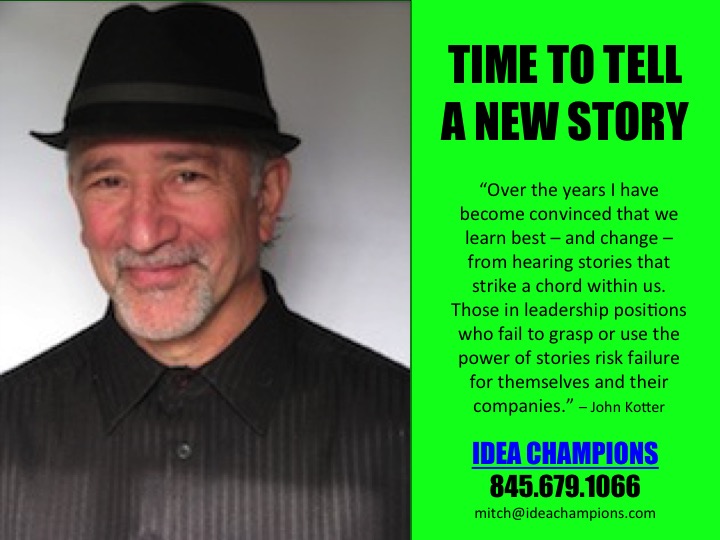
One of the biggest challenges that internal change agents have when it comes to fostering a culture of storytelling in the workplace is building the business case -- why it matters and what the impact can be. The quote below, from John Kotter, author of Leading Change, will help. If you need help building your case, shoot me an email and I will send you some more "grist for the mill" -- links to compelling articles and videos on the topic.
Storytelling at Work: the blog
Storytelling at Work: the book
The author of both
Posted by Mitch Ditkoff at 08:06 AM | Comments (0)
April 22, 2017FREE ONLINE POLL: How to Improve Your Company's Ideation Process

Here's the simplest way to figure out how to improve your company's ideation process: Enter Idea Champions' FREE IDEATION POLL CONTEST. Just send an email to office@ideachampions and write "Ideation Poll" in the subject line. We'll put your name in the proverbial hat on May 1st and, blindfolded, pick out three winners.
If YOU are one of the winners, we'll send you a link to our ideation poll which you, in turn, will forward to your workforce. A week after that we'll send you the results along with a some useful "food for thought". The value? You will better understand where the holes are in your company's idea generation bucket so you can patch them up or begin figuring out how to get a different bucket. Sneaky marketing shtick from us? None. Nada. Zero. Zilch.
What our clients say about us.
50 quotes on the power of ideas
More about ideation process
Posted by Mitch Ditkoff at 01:34 PM | Comments (0)
April 16, 201714 Ways to Get Breakthrough Ideas
There's a lot of talk these days about the importance of innovation. All CEOs worth their low salt lunch want it. And they want it, of course, now.
What sparks innovation? People. What sparks people? Inspired ideas that meet a need, whether expressed or unexpressed -- ideas with enough mojo to rally sustained support. Is there anything a person can do -- beyond caffeine, corporate pep talks, or astrology readings -- to quicken the appearance of breakthrough ideas?
Yes, there is. And what follows are 14 catalysts -- simple guidelines, principles, and approaches that will help you on your way.
1. FOLLOW YOUR FASCINATION
If you find yourself fascinated by a new idea, chances are good that there's something meaningful about it for you to consider. Fascination, quite simply, is nature's way of getting our attention. Well beyond seduction or attraction, it's an indication that we are being called. Out of the thousands of ideas with the power to capture our imagination, the felt fascination for one of them is a clue that there's something worthy of our engagement.
Don't dismiss it as trivial. Give it room. Give it time to breathe. Honor it. If you have any doubt, consider the origins of the word "fascination". It comes from the Latin "fascinus," meaning to be "enchanted or delighted."
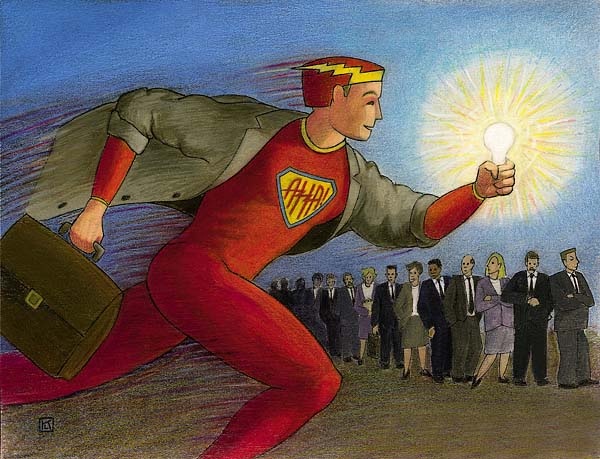
What enchants or delights us is sacred -- or could be sacred -- a clue that something significant is knocking on our door. Indeed, if we are willing to let fascination grow inside us, a kind of immaculate conception can occur, the illogical, miraculous becoming pregnant with possibility -- the bodily expression of the phenomenon that you are here to birth something extraordinary.
The idea is simply the first "waaaaaaah" to get you to notice.
What new idea is fascinating you? What new possibility has captured your attention? In what ways can you honor this inspiration today?
2. IMMERSE
Breakthrough ideas, like telemarketers or Jehovah's Witnesses, have a curious habit of showing up at odd times. And because they do, we're not always ready to receive them. To complicate matters, chances are good that when they do show up, we are multi-tracking our little tushies off -- checking email, microwaving dinner, or looking for our Smart Phone amidst the half-folded laundry. Not exactly the pre-conditions for breakthrough.
The alternative? Immersion -- the act of becoming completely involved or absorbed in something -- engrossed, enthralled, or preoccupied."
If you want to radically increase your odds of originating breakthrough ideas, you will need to immerse. Don't be a chicken, be a hen! Baby chicks break through the shell separating them from flight not because their mothers are rushing off to meetings on parenting skills, but because their mothers are immersed in the act of hatching. Mommy is sitting in one place for a looooooooong time. And baby chick is also sitting (curled up) in one place for a looooooooong time.
At Google, employees are given 20% of their time to immerse in projects that have nothing seemingly to do with their so-called day job. At 3M, it's 15%. W.L. Gore gives employees a half a day each week to immerse in projects that fascinate them.
Look at your calendar. Block out some time to focus on the development of your most inspired idea or venture. Unplug! Incubate! Hatch! Immerse!
3. TOLERATE AMBIGUITY
Breakthrough ideas are not always the result of a revolutionary Eureka moment. On the contrary, they are often the result of an evolutionary series of approximations or failed experiments. When Thomas Edison was asked how it felt to fail 800 times before coming up with tungsten as the filament for the light bulb, his answer was a revealing one.
"Fail?" he said. "I didn't fail once. I learned 800 times what didn't work."
Edison had the ability to tolerate ambiguity -- to "not know." Like most breakthrough thinkers, he had the ability to dwell in the grey zone. Confusion was not his enemy.
"Confusion," explained Henry Miller, "is simply a word we have invented for an order that is not yet understood."
If you are attempting to birth a breakthrough idea, get comfortable with discomfort. Give up your addiction to having all your ducks in a row, at least in the beginning of your discovery process. People may think you're a quack, but so what? Your chances of birthing a breakthrough idea (and result) exponentially increase the more you are able to tolerate ambiguity.
What new idea of yours is bubbling on the brink of breakthrough? In what ways can you stay with it, even if something in you is impatient for a breakthrough?

4. MAKE NEW CONNECTIONS
True creativity rarely happens in a vacuum. On the contrary it is the product of two or more variables connecting in a new way. It happens all of the time in nature. Water, for example, is really just the connection between hydrogen and oxygen. It happens in the human realm as well. Roller blading is nothing more than the connection between ice skating and roller skating. MTV? Nothing more than the connection between music and television. Drive in banking? Car + banking.
The originators of these breakthrough products didn't pull rabbits out of hats. All they did was see a new, intriguing (and potentially commercial) connection between already existing elements.
Why don't more of us make these kinds of connections? Because we usually stay within the confines of what we already know. We live in a box of our own creation -- whether that box be defined by our nationality, profession, concepts, cubicle, or astrological sign.
The more we are willing to get out of this box, the more likely it will be that powerful new connections will reveal themselves to us -- uncommon linkages between this, that, and the other thing -- kind of the way it was for Johannes Gutenberg when he noticed a previously undetected connection between the wine press and coin punch. And so the printing press was born.
Make three parallel lists of ten words. The first list? Nouns. The second list? Verbs. The third list? Adjectives. Then look for intriguing new connections between them.
5. FANTASIZE
In 1989, Gary Kasparov, the Soviet Union Grand Chess Master, played a two game match against "Deep Blue," the reigning supercomputer of the time. Kasparov won easily. When asked by the media what his competitive advantage was, he cited two things: intuition and the ability to fantasize. (And this, from a master strategic thinker!)
Few of us are ever encouraged to fantasize -- a behavior most commonly associated with children or perverts. And yet, fantasizing is exactly how many breakthrough ideas get their start -- by some maverick, flake, or dreamer entertaining the seemingly impossible.
I find it curious that business leaders want their employees to come up with fantastic ideas or solutions, but they don't want their employees to fantasize. And yet, the words "fantastic" and "fantasy" come from the same linguistic root, meaning to "use the imagination."
Think of a current challenge of yours. What would a fantasy solution to this challenge look like? What clues does this fantasy solution give you?
6. DEFINE THE RIGHT CHALLENGE
"It's not that they can't find the solution," said G.K. Chesterton, the renowned American philosopher and writer, "They can't find the problem!"
Translation? Most people, in their rush to figure things out, rarely spend enough time framing their challenge in a meaningful way. If they owned a GPS, they'd fail to take the time to program in their destination because they were so much into the hustle of getting out of town. Coming up with the right question is at least half of getting the right answer.
If you want a breakthrough idea, begin by coming up with a breakthrough question -- one that communicates the essence of what you're trying to create.
State your most inspired challenge or opportunity as a question beginning with words "How can I?" Then write it three different ways. Which is your real question?

7. LISTEN TO YOUR SUBCONSCIOUS
If you study the lives of people who have had Eureka moments, you'll note that their breakthroughs almost always came after extensive periods of intense, conscious effort. They worked, they struggled, they noodled, they gave up, they recommitted -- and then the breakthrough came. And often at unexpected moments. They weren't buying lottery tickets at their local deli, hoping to win a breakthrough fortune, they were digging for treasure in their own back yard.
Rene Descartes got the idea for the Scientific Method in a dream. Richard Wagner got the idea for Das Rhinegold while stepping onto a bus after long months of creative despair. Einstein used to conduct "thought experiments" (a fancy name for daydreaming) whenever he got stuck.
In other words, the conscious mind works overtime in an attempt to solve a problem or achieve a goal. Unable to come up with the breakthrough, the challenge gets turned over to the subconscious mind which then proceeds to figure it out in its own, sweet time.
Of course, all of this assumes that we are listening to the promptings of our subconscious mind.
This week, keep a log of your most inspired ideas, intuitions, and dreams. At the end of the week, review your log. See what insights come to you.
8. TAKE A BREAK
If you want a breakthrough, you will need to take a break. True innovators rarely follow the straight and narrow path. Not only do they march to a different drummer, they're often not even on the same playing field as most people.
Take Seymour Cray, for example, the legendary designer of high-speed computers. He used to divide his time between building the next generation super computer and digging an underground tunnel below his Chippewa Falls house. Cray's explanation of his tunnel digging behavior is consistent with the stories of many other creatives -- inner-directed, boundary-pushing people who understand the need to go off-line whenever they get stuck.
Bottom line, whenever they find themselves struggling with a thorny problem, they walk away from it for a while. They know, from years of experience, that more (i.e. obsession, analysis, effort) is often less (i.e. ideas, solutions, results).
Explained Cray, "I work for three hours and then get stumped. So I quit and go to work in the tunnel. It takes me an hour or so to dig four inches and put in the boards. You see, I'm up in the Wisconsin woods, and there are elves in the woods. So when they see me leave, they come back into my office and solve all the problems I'm having. Then I go up (to my lab) and work some more."
Next time you find yourself stuck on a thorny problem or project, walk away from it for a while. Stay conscious of new solutions coming to you during this down time.
9. NOTICE AND CHALLENGE PATTERNS AND TRENDS
There are many people these days who make their living from the pattern recognition business: futurists, meteorologists, air traffic controllers, and stock brokers just to name a few. And while their success rates may not always be 100%, it is clear that whatever success they enjoy is intimately tied to their ability to notice patterns and then interpret those patterns correctly for the rest of us.
The same holds true for breakthrough thinkers. The only difference? Breakthrough thinkers often hit the gravy train by challenging old patterns and then reconfiguring them in new ways.
"The act of creation," said Picasso, "is first of all an act of destruction."
"The genius," said American painter, Ben Shahn, "is merely the one able to detect the pattern amidst the confusion of details just a little sooner than the average man."
What trends in the marketplace most intrigues you? In what ways might these trends shift in the coming years -- and how might your most inspired idea be in sync with this imagined shift?

10. HANG OUT WITH A DIVERSE GROUP OF PEOPLE
Years ago Sony used to insist that their engineers spend at least 25% of their work time out of the office and mixing it up with people outside of the four walls of their industry. Keepers of the innovation flame at Sony understood that diverse inputs were essential to the origination and development of breakthrough ideas.
Unfortunately, most of us tend to stay within the intellectual ghettos of the familiar. We hang out with the same people day and night -- usually people who either agree with us, report to us or, through some indefinable act of karma, are joined to us at the hip.
If you want to increase your chances of getting a breakthrough idea, you will need to break the bonds of the familiar. Hang out with a different crowd. Go beyond the usual suspects. Seek the input of oddballs, mavericks, outcasts, or, at the very least, people outside your field. If you can let go of your need for comfort and agreement, you will find yourself catapulted into new ways of seeing, thinking, and acting -- all precursors to breakthrough ideas.
Make a list of ten people outside of your traditional posse that you can spend some time with this month.
11. BRAINSTORM
Breakthrough thinkers are often rugged individualists. They believe in their inalienable rights to think for themselves. They value their opinions, their perspectives, and their innate creativity. Their biggest fear is group think. All well and good.
But there is an important distinction to be made between group think and the phenomenon of inspired individuals getting together to spark each other's brilliance. Indeed, most great breakthroughs are more about inspired collaborations than they are about lone wolf genius.
Think Bill Gates and Paul Allen (Microsoft), Steve Jobs and Steve Wozniak (Apple), Sergey Brin and Larry Page (Google), David Filo and Jerry Yang (Yahoo), Watson and Crick (DNA), Lennon and McCartney (the Beatles), Hewlett & Packard.
All you need to do is frame a meaningful question, invite the right people, and facilitate the process for helping your think tank creatively jam. If you are not the right person to facilitate, you probably know someone who is. Ask them.
What is the topic of your next group brainstorm? Who will you invite? Who will facilitate? When?
12. LOOK FOR HAPPY ACCIDENTS
Breakthrough ideas are often less about the purposeful act of inventing new things that it is the art of noticing new things that happen accidentally -- those surprise moments when the answer is revealed for no particular reason.
The discovery of penicillin, for example, was the result of Alexander Fleming noting the formation of mold on the side of a Petri dish left unattended overnight. Vulcanized rubber was discovered in 1839 when Charles Goodyear accidentally dropped a lump of the polymer substance he was experimenting with onto his wife's cook stove.
Breakthroughs aren't always about inventions, but about the intervention required to notice something new, unexpected, and intriguing. For this to happen, you will need to let go of your expectations and assumptions and get curious. Give up being an expert. Let go of the past. See with new eyes.
What failed experiment or unexpected outcome might be interesting for you to reconsider?

13. USE CREATIVE THINKING TECHNIQUES
I live in the Northeast. In the Winter, it's common for old cars, especially on very cold mornings, not to start. When this happens, the best thing you can do is get a jump start. All you need are jumper cables and another car that's got its motor running.
Creative thinking techniques are like jumper cables. They spark ignition. They turn potential into kinetic energy. They get you going when you're stuck. If you're looking for a breakthrough idea, perhaps all you need is a jump start. That jump start can take many shapes. It can be a classic, creative thinking technique, of which there are many. It could be a "creative thinking coach" or a favorite book, or a quote. Ultimately, it doesn't matter what medium you choose, just as long as you choose something to get your motor running.
What is one creative thinking technique you might use the next time you need a jump start on the job?
14. SUSPEND LOGIC
Perhaps Einstein said it best when he declared: "Not everything that can be counted counts; and not everything that counts can be counted."
He was referring, of course, to the part of the human being that knows intuitively -- the part that is tuned in, connected, and innately creative. Kids live in this place. The rest of us just visit, preferring the left-brained world of rationality, logic, linearity, and analysis.
On some primal level, we're all from Missouri. We need proof. And while there is nothing inherently wrong with gathering data, the addiction to it subverts our ability to originate breakthrough ideas.
We know this. That's why we go to the movies, the pub, watch TV, read novels, dial 900 numbers, and daydream. We seek an altered state, one that is free of the normal gravity of daily life. That's why movie makers ask us to suspend disbelief. That's why brainstorm facilitators ask us to suspend judgment. That's why women (innately intuitive as they are) ask the men in their lives to stop being so damn practical for a change and actually feel something.
It is in this state of suspension that our innate creativity is free to percolate to the surface -- over, under and around all of the left brained guardians at the gate. And so... if you want to really birth a breakthrough idea, you too will need to enter into this state -- at least in the first phases of your new venture. Suspend judgment. Suspend evaluation. Suspend your addiction to the practical. What exists on the other side is fuel for the fire of your untapped creativity.
What can you do this week to suspend practicality, logic and rationality in service to birthing your big idea?
Posted by Mitch Ditkoff at 04:39 AM | Comments (1)
March 24, 2017Free Online Innovation and Creativity Summit 2017
Here's Nick Skillicorn introducing the upcoming, online Innovation and Creativity Summit 2017. I am happy to announce that I will be one of the 45 presenters. My topic? The power of storytelling to spark innovation. Cost? Zero. Zippo. Zilch. Click here to register. Summit begins on April 2.
MitchDitkoff.com
Storytelling at Work
Posted by Mitch Ditkoff at 10:53 AM | Comments (0)
December 17, 2016How to Facilitate Breakthrough Brainstorming Sessions for Your Clients in Three Hours or Less

Here's the deal: You are one of the creatives in a high flying PR, Marketing, or Communications company and have been asked by one of your clients to lead an upcoming brainstorming session. That's the good news. The-not-so-good news? Even though you're an idea-generating machine, facilitating sessions that bring out brilliance in others is not your forte. And to raise the stakes even higher, your client wants more than just "ideas". Your client wants remarkable, actionable ideas and wants the session to be highly engaging, energizing, and worth their precious time. Get it? The heat is on, big time.
Idea Champions can teach you how
Posted by Mitch Ditkoff at 04:08 PM | Comments (0)
June 30, 2016BETTER THAN THERAPY: What Stressed Business Partners Can Learn From the Police Reunion Tour
Making great music together isn't always easy, no matter how famous your band is. Nor is it easy being business partners, collaborators, teammates, or "significant others". If you want to make some serious music together, "creative dissonance" is inevitable. Count on it. The question isn't whether or not band mates or business partners will experience breakdowns. They will. The question is how committed are they to breaking through and coming out the other side.
Idea Champions
Bridging the Gulf
Becoming an Adaptive Leader
Our clients, past and present
Posted by Mitch Ditkoff at 07:43 PM | Comments (0)
June 07, 2016HOW TO GET PEOPLE OUT OF THE BOX: A 5-Minute Tutorial

Ever heard the expression "get out of the box?" Of course you have. Ever wonder what the six sides of that so-called box actually are? If not, here's your 5-minute tutorial of the day. Once you're clear about what the sides of the box are, you will be significantly more able to help people (and yourself) get out of it.
One way to get out of the box
Another way
My book on the subject
Boxes
Posted by Mitch Ditkoff at 11:24 AM | Comments (0)
April 04, 2016The Crowdsourced Birth of a New Book Beyond Business Innovation
Greetings! It's me, Mitch Ditkoff, author of this blog, President of Idea Champions, writer, speaker, husband, father, and dust particle. If you've been enjoying this blog, there is a good chance you will enjoy my forthcoming book. Towards that end, I have just launched a GoFundMe campaign and am inviting you to participate. We're talking crowd-sourced funding -- a way for me to buy the time and resources I need to write, produce, publish, and promote the book before hell freezes over. Hope you can be part of it! It takes a village... and a few village idiots!
Click here to find out more
Click here if you don't want to find out more
Posted by Mitch Ditkoff at 02:51 PM | Comments (0)
September 15, 2015The Art of Sparking Innovation
When my mother was alive, she told me she had no idea what I did for a living. Around the canasta table, she would tell her friends I was a "motivational speaker", no matter how many times I explained what I actually did. The slide show below is dedicated to her and to YOU, too -- especially if you're wondering what the heck goes on in one of Idea Champions' innovation-sparking workshops. Best to view full screen.
Posted by Mitch Ditkoff at 05:18 PM | Comments (0)
October 07, 2014THE SEED OF INNOVATION MOMENT: A 3-Minute Video Tutorial

If you are trying to spark a renaissance of innovation in your company by launching some kind of "innovation initiative", consider the fact that the seed of innovation is already available in every conversation that people are having. This 3-minute video tutorial dives in deeper.
The Seed of Innovation keynote
Create change agents
A more structured way to do this
Posted by Mitch Ditkoff at 03:51 PM | Comments (0)
February 19, 2014How to Open the Door to Innovation

There is no magic pill, but there is a key. And the key has a lot to do with creating a critical mass of savvy innovation catalysts and change agents who know how to open doors (and minds).
Posted by Mitch Ditkoff at 08:32 PM | Comments (0)




